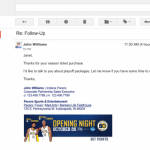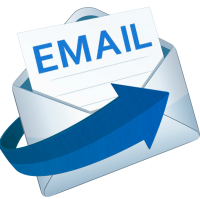Three Email Habits That Kill Your Whole Team’s Productivity
Eric, a client of mine, owned and ran a successful service firm with sales of $3.5 million per year and a healthy profit margin. But, he told me, “We’re bursting at the seams. I’m working six or seven days a week, putting in 70-plus hours a week, and my team are all regularly working 60-plus hours a week. Is it that I just need to hire more staff?”
He didn’t think so, but wasn’t sure what else to do. “We’ve got a solid team here, and I don’t want to make it any more complicated,” he added. After hashing things out together, it became clear that the overload Eric and his company were experiencing wasn’t just a staffing issue. It was more likely a productivity one, starting with how Eric communicated with his staff. Three of his bad email habits were trickling down to everybody else, undermining the entire team’s working methods.
Make no mistake: They’re widespread in other companies, too. And especially when leaders misuse email, the negative consequences for others can quickly become magnified. Here’s what to watch out for.
1. Hyper-Responsiveness
If you’re constantly checking your inbox—or even worse, getting push notifications that prod you to—chances are you aren’t using email very effectively. Over time, that makes email itself a source of anxiety. My client confessed to feeling uncomfortable as a result of simply not knowing what was in his inbox, and he worried that if he didn’t stay on top of it, he would drown in it.
These are fallacies that can quickly become self-fulfilling prophecies. First, it means your attention is constantly getting pulled from higher-value activities so you can handle an incoming message—often a trivial one. As UC Irvine researcher Gloria Mark discovered, it takes the average office worker 20 minutes to return from that interruption to whatever they were doing before.
Hyper-responsiveness to email doesn’t just chop your day into a series of small slivers of work punctuated by distraction, it also increases the volume of email you’re likely to get. And if you’re a leader, that can magnify your entire team’s email load proportionately. Think of it this way: The faster you reply, the more responses you’ll get in. If you write a total three notes to a team member about the same project in the space of an afternoon, that means they’ve likely written three, too—one of theirs alternating with one of yours—for a six-email thread. But if you’d just waited to check in until the end of the day or the following morning, you’re only writing one note apiece.
One of the best ways to reduce your total email load is to let it “age”—in other words, simply waiting for an hour or two before you reply, or holding your reply for the next day. This allows you to “batch” your time spent responding to email during defined periods, then ignore it the rest of the time so you can focus on other things.
When leaders do this, they give their teams tacit permission to do the same. But it helps to be explicit about it: Discuss hyper-responsiveness with your team and make it clear you consider it a risk to avoid, not a bad habit to indulge.
2. Nighttime And Weekend “Check-Ins”
“Eric, how often do you handle an email that is so important that it couldn’t wait until the next workday to respond to?” I asked my client.
“Rarely,” he said. “But I like staying on top of my email. I want to know what’s in there. And it’s easier to send the response right then and there versus having to reread it a second time the next workday.” That meant Eric was checking in on his messages after-hours and on weekends, which put pressure on his team members to do the same. Over time, this became part of the company’s culture, leaving no one with truly uninterrupted downtime to recharge away from work.
Cutting back on this habit wasn’t going to be a cold-turkey kind of thing, I realized. Understanding that Eric felt compelled to check his email and respond immediately, I suggested he start writing his replies right away but use the “delay delivery” feature so the email gets sent the next workday.
If you’ve had a history of late-night emails to your team, you need to acknowledge it first to yourself and then to your team members. Since it affects them, too, it isn’t just a personal quirk you can deal with solo. Bring it up at your next team meeting. Come clean with them about the bad habit and discuss it candidly: When do you and they feel it’s important—for the company—for everyone to be available by email? Just make sure you can clearly define the business goals you’re serving by whatever timeframe or regularity you agree to; if you can’t, think again.
3. Over-CC’ing
“Eric,” I said, “I noticed on the agenda I emailed you for this call that you cc’ed two of your team members. May I ask why?”
“Oh, you had asked for some information in advance of our meeting, and I was delegating it out.”
“Okay,” I said, “That makes sense, but why two people?”
“I always send administrative tasks to two people,” he replied. “That way I know at least one of them will handle it.”
In your company, do people often feel they have to cc multiple parties, even on mundane emails? Do you notice that people who are only tangentially affected get copied in on the responses to a cc’d email?
You may think you’re just keeping folks in the loop. But remember that every email has to be opened, read, mentally processed, and then “handled,” even if that just means moving the email to an archive folder or deleting it. Be intentional about when you do and don’t cc someone, and work with your team to determine what situations warrant cc’ing and which ones don’t. Here’s a good rule of thumb: If you want someone to do something with the information you’re sharing, include them. Otherwise, think twice.
Your team members may share these email habits or even exhibit some of them that you don’t. But as a leader, the way your whole team communicates starts with how you communicate with them.
related video: This CEO’s Trick At Getting To Inbox Zero
David Finkel is coauthor of the bestselling SCALE: 7 Proven Principles to Grow Your Business and Get Your Life Back.
Fast Company , Read Full Story
(13)














